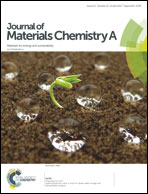A black/red phosphorus hybrid as an electrode material for high-performance Li-ion batteries and supercapacitors
Abstract
A single elemental hybrid composed of black phosphorus (BP) and red phosphorus (RP) is synthesized via a feasible sonochemical method. BP and RP can construct a new single elemental heterostructure. This kind of structure with an excellent interfacial contact between BP and RP would be beneficial to electron transfer and exhibits a superior electrochemical performance. Compared with the sole RP, the as-prepared BP/RP hybrid exhibits enhanced electrochemical performances as an electrode material for both lithium-ion batteries and supercapacitors. For lithium-ion battery applications, the BP/RP hybrid provides a high cycling performance with an initial discharge capacity of 2449 mA h g−1 and a reversible capacity of 491 mA h g−1 after 100 cycles. For supercapacitor applications, the specific capacitance of the BP/RP hybrid achieves a high value up to about 60.1 F g−1 and a long cycling life with a capacity retention of 83.3% after 2000 cycles. The present study demonstrates that the BP/RP hybrid has potential for application as an electrode with high performances in electrochemical energy-storage devices.



 Please wait while we load your content...
Please wait while we load your content...